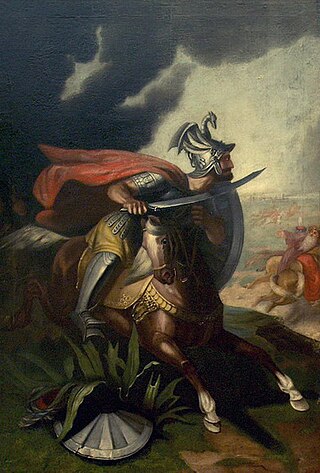
Miloš Obilić was a legendary Serbian knight who is reputed to have been in the service of Prince Lazar during the Ottoman invasion of Serbia in the late 14th century. He is not mentioned in contemporary sources, but features prominently in later accounts of the 1389 Battle of Kosovo as the assassin of Sultan Murad. Although the assassin remains anonymous in sources until the late 15th century, the dissemination of the story of Murad's assassination in Florentine, Serbian, Ottoman and Greek sources suggests that versions of it circulated widely across the Balkans within half a century of the event.
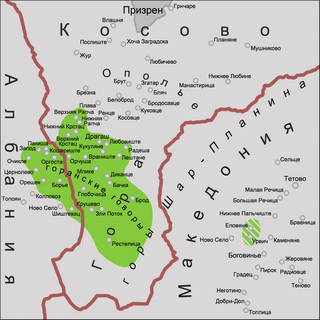
The Gorani or Goranci, are a Slavic Muslim ethnic group inhabiting the Gora region—the triangle between Kosovo, Albania, and North Macedonia. They number an estimated 60,000 people, and speak a transitional South Slavic dialect, called Goranski. The vast majority of the Gorani people adhere to Sunni Islam.
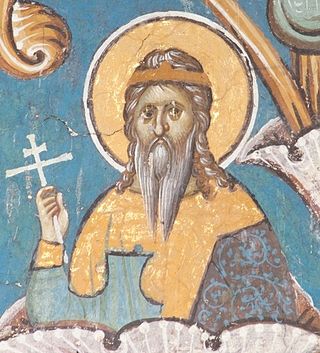
Vladislav was the King of Syrmia from 1316 to 1325, and claimant to the Serbian Kingdom.
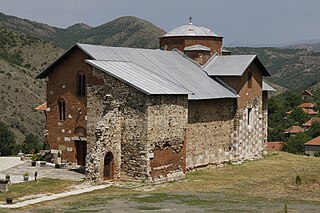
The Banjska Monastery is a Serbian Orthodox monastery in the Banjska village near Zvečan, Kosovo.
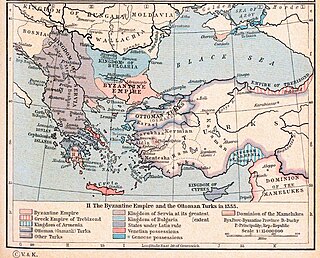
The History of the Serbs spans from the Early Middle Ages to present. Serbs, a South Slavic people, traditionally live mainly in Serbia, Montenegro, Bosnia and Herzegovina, Croatia and North Macedonia. A Serbian diaspora dispersed people of Serb descent to Western Europe, North America and Australia.

The Patriarchate of Peć Monastery or the Patriarchal Monastery of Peć, is a medieval Serbian Orthodox monastery located near the city of Peja, Kosovo. Built in the 13th century, it became the residence of Serbian Archbishops. It was expanded during the 14th century, and in 1346, when the Serbian Patriarchate of Peć was created, the Monastery became the seat of Serbian Patriarchs. The monastery complex consists of several churches, and during medieval and early modern times it was also used as mausoleum of Serbian archbishops and patriarchs. Since 2006, it is part of the "Medieval Monuments in Kosovo", a combined World Heritage Site along with three other monuments of the Serbian Orthodox Church.
The Battle of Velbazhd took place between Bulgarian and Serbian armies on 28 July 1330, near the town of Velbazhd.

The Realm of Stefan Dragutin was a medieval Serbian kingdom. Initially, it was a vassal kingdom of the Kingdom of Hungary, but subsequently became an independent kingdom, after the collapse of the central power in the Kingdom of Hungary. It was ruled by the Serbian kings Stefan Dragutin (1282–1316) and his son Stefan Vladislav II (1316–1325). The kingdom was centered in the region of Lower Syrmia and its first capital was Debrc, while residence of the king was later moved to Belgrade.
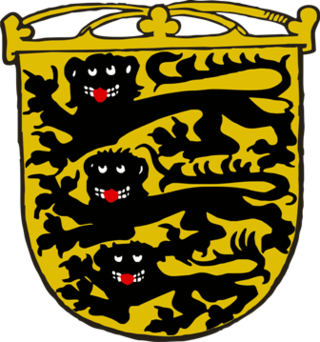
The House of Shishman, also referred to as the Shishmanids or Shishmanovtsi, was a medieval Bulgarian dynasty of Turkic Cuman origin. The House of Shishman ruled the Second Bulgarian Empire from the proclamation of Michael Asen III as emperor in 1323 to the deposition of his son Ivan Stephen in 1331 whereafter rule fell to the House of Sratsimir, who were matrilineal descendants of the Shishmanids.

Gavrilo Dožić, also known as Gavrilo V, was the Metropolitan of Montenegro and the Littoral (1920–1938) and the 41st Serbian Patriarch of the Serbian Orthodox Church, from 1938 to 1950.

The Church of the Virgin Hodegetria was a 14th-century Serbian Orthodox church in Mušutište, near Suva Reka, Kosovo,. The church was destroyed by Kosovar Albanian forces during the destruction of the Serbian part of Mušutište, after the end of the Kosovo war in 1999.

Darman and Kudelin were two Bulgarian boyars of Cuman origin who jointly ruled the regions of Braničevo and Kučevo in the late 13th century (1273–1291). The two brothers used the weakened state of centralized administration in the region to become independent from the Kingdom of Hungary or the Second Bulgarian Empire in 1273. The capital of their domains was the fortress of Ždrelo, on the Mlava river. Relying on auxiliary troops that consisted mostly of Tatar and Cuman mercenaries, the brothers were “very independent-minded and afraid of no one”, according to Serbian archbishop Danilo II.
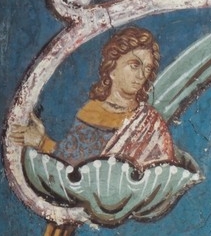
Urošica was a Serbian prince and Orthodox monk, a member of the Nemanjić dynasty. He was the younger son of Stefan Dragutin, King of Serbia 1272–1282 and Syrmia 1282–1316. Dragutin kept Syrmia after passing the rule to Stefan Milutin in 1282. Through mother Catherine of the Hungarian Árpád dynasty, the elder son Stefan Vladislav II was the Duke of Slavonia from 1292 and the King of Syrmia from 1316 until 1325. Urošica took monastic vows as Stefan (Стефан), and is venerated as a saint by the Serbian Orthodox Church on November 11 [O.S. November 24].

Eparchy of Raška and Prizren is one of the oldest eparchies of the Serbian Orthodox Church, featuring the seat of the Serbian Orthodox Church, the Serbian Patriarchal Monastery of Peć, as well as Serbian Orthodox Monastery of Visoki Dečani, which together are part of the UNESCO World Heritage sites of Serbia. More than 100 of the Eparchy's churches and monasteries were targeted for vandalism and destruction by Albanian nationalists after the Kosovo War and during the 2004 unrest in Kosovo.
The Vullnetari were a volunteer militia of Albanians from Kosovo set up in 1941 by Italian forces after the successful invasion of Yugoslavia. They served as an auxiliary force for civilian control and protection of villages.

Despot S. Badžović was a teacher and an activist of the Serbian national movement in Macedonia. Badžović was also one of the early Macedonists, who developed some kind of pro-Serbian Slav Macedonian identity.

The Serb uprising of 1596–1597, also known as the Herzegovina uprising of 1596–1597, was a rebellion organized by Serbian Patriarch Jovan Kantul and led by Grdan, the vojvoda ("duke") of Nikšić against the Ottomans in the Sanjak of Herzegovina and Montenegro Vilayet, during the Long Turkish War (1593–1606). The uprising broke out in the aftermath of the failed Banat Uprising in 1594 and the burning of Saint Sava's relics on 27 April 1595; it included the tribes of Bjelopavlići, Drobnjaci, Nikšić, and Piva. The rebels, defeated at the field of Gacko in 1597, were forced to capitulate due to a lack of foreign support.
The siege of Braničevo was laid by Hungarian king Géza II against Byzantine-held Braničevo in late 1154.
The First Balkan Alliance was a system of agreements concluded by the Principality of Serbia in the period of 1866–68 to unite the nations of the Balkans in a common struggle against the Ottoman Empire. The plans for forging this alliance were based on the organization of a major general uprising, as opposed to individual uprisings by the various ethnic groups in Ottoman territory. According to the plans, the Albanians would begin the uprising, followed by Serb and Greek volunteers and finally and simultaneously by the regular armies of Serbia and Greece. According to the plans and agreements, after a successful war against the Ottomans, the Balkan nations would establish a united federation.

Cathedral of Saint George in Prizren is the Cathedral church of the Serbian Orthodox Eparchy of Raška and Prizren, located in the town of Prizren, Kosovo. It was built from 1856 to 1887, near the Old Church of Saint George, previous cathedral church of the same eparchy. The cathedral was burned and severely damaged by Albanian mobs during the 2004 unrest, but was later renovated.














